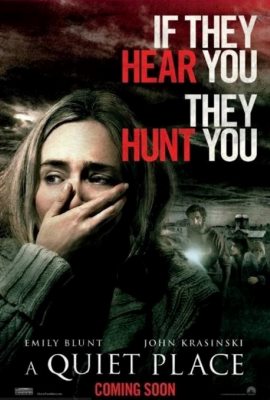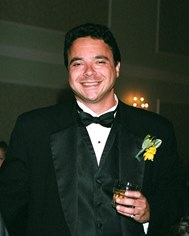 Employing a tried-and-true horror movie gimmick, “A Quiet Place” impresses more by focusing on a family in peril than the fanged creatures hunting them should they make the slightest sound. Tense and taut, none of the film’s 90 minutes are wasted- it’s one of the most effective and suspenseful horror movies I’ve seen in a long time.
Employing a tried-and-true horror movie gimmick, “A Quiet Place” impresses more by focusing on a family in peril than the fanged creatures hunting them should they make the slightest sound. Tense and taut, none of the film’s 90 minutes are wasted- it’s one of the most effective and suspenseful horror movies I’ve seen in a long time.
The film’s prologue tells you all you need know: John Krasinski deftly directs, co-writes, and stars as Lee Abbott who, in what we later learn is the year 2020, finds himself, wife Evelyn (real-life wife Emily Blunt), and his three children in Day 89 of a nightmare-world scenario. The town’s streets are deserted as they quietly loot the local pharmacy for medicine for one of their sick children, Marcus (Noah Jupe). While we see their oldest child Regan (Millicent Simmons) is wearing a hearing aid and they use sign language to communicate with one another, the apocalyptic atmosphere belies a greater truth for their silence. When their youngest, 4-year old Beau (Cade Woodward), picks up a toy, the whole family freezes- Lee calmly and quietly waves for Beau to give him the toy, slowly removing the AA batteries from it as if he were dismantling a bomb. Placing them separately on the pharmacy’s counter, they leave one-by-one: the last two out the door are Regan, who gives Beau the now-harmless toy and Beau, who secretly pockets the batteries. Once outside, Beau uses the batteries to activate the toy and we discover why noise is a no-no: the squealing toy has alerted a monster in the woods nearby.
A year and a half later, things haven’t improved for the Abbotts. Back in the basement of their farmhouse, we see Lee has electronic expertise, repairing Regan’s hearing aids and creating a command center where he can try to transmit S.O.S signals through a radio he’s built, the signals always going unanswered. Lee’s also kept tabs on the creatures outside, marking up their characteristics on a whiteboard as he tries to uncover their weakness: we learn these monsters are blind, have protective armor and attack sound. Just as we don’t know how Lee acquired his electronic aptitude, we also don’t know where these creatures came from, and that’s the beauty of “A Quiet Place:” it doesn’t matter. The film avoids wasteful exposition in the same way Marisa Tomei set Joe Pesci straight in “My Cousin Vinny” when he tried to decide what pants to wear hunting- do you think it matters to the deer you shoot?
Seeing the Abbotts quietly go about their daily lives, or what’s left of it with the ever-present monsters waiting outside for a loud noise to locate the family, we notice something else: Evelyn is pregnant. While Evelyn might be able to stifle screaming during childbirth and the Abbotts have soundproofed the basement in preparation for the din of delivery, the natural cries of a newborn are sure to create chaos. This foreshadowing of fear and the smart solving of anticipated agony is one of the things “A Quiet Place” does so well.
It’s a great horror movie gimmick using anything natural we do as bait for attack from monsters we don’t understand: just look at how our necessity for sleep was used against us in movies like “Invasion of the Body Snatchers” or “A Nightmare on Elm Street.” Even sound used previously in thrillers like “Don’t Breathe” or “Wait Until Dark” have proved effective. But it’s in “A Quiet Place” where Krasinski really capitalizes on the ironic twists our sounds can create: screams as an effective form of suicide; the noisy clamor to not suffocate alerting creatures who’ll kill you another way. With sound as the key factor to “Quiet’s” story, I haven’t seen the subject handled and executed as well in a film since Francis Coppola’s wiretapping thriller “The Conversation.”
So if you were starting to bemoan Hollywood not being able to produce a horror movie as effective and entertaining as last year’s “Get Out,” stifle yourself- John Krasinski and the creatures that roam his “Quiet Place” have heard you.
